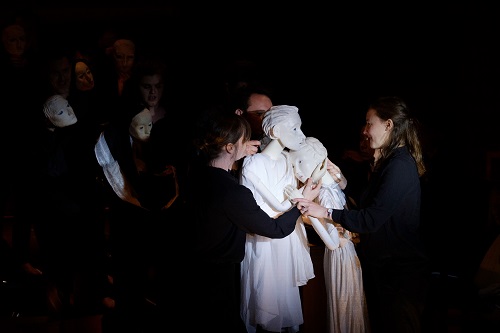 United Kingdom Monteverdi, L’Orfeo: Soloists, I Fagiolini (director: Robert Hollingworth) with Music and Theatre for All, Jerwood Hall (LSO St Luke’s), London, 7.7.2019. (AK)
United Kingdom Monteverdi, L’Orfeo: Soloists, I Fagiolini (director: Robert Hollingworth) with Music and Theatre for All, Jerwood Hall (LSO St Luke’s), London, 7.7.2019. (AK)

Production:
Stage director – Thomas Guthrie
Musical director – Robert Hollingworth
Designer – Ruth Paton
Puppeteers – Alex Newton, Laura Caldow
Cast:
Orfeo – Matthew Long
Euridice – Jenni Harper
La Musica/Messaggiera – Clara Hendrick
Ninfa/Proserpina – Eleanor Minney
Speranza/Shepherd – William Purefoy
Apollo/Shepherd – Nicholas Hurndall Smith
Infernal Spirit/Shepherd – Greg Skidmore
Caronte – Christopher Adams
Plutone/Shepherd – Charles Gibbs
This performance of Monteverdi’s L’Orfeo, presented by I Faglioni with Music and Theatre for All, was exceptional for many reasons. Rarely do meaningful scholarship and artistry join in such harmony as here; rarely do we experience such subservience to music as on this occasion. The commands of La Musica in the Prologue, urging us to listen, were duly observed on all levels. Ensemble work in conjunction with astonishing multitasking provided a spellbinding, multilayered and deeply satisfying trip to the world of Monteverdi’s L’Orfeo.
Stage director Thomas Guthrie uses puppets to tell the story of the mortals but portrays immortals of Hades (Caronte, Prosperina and Plutone) and Heaven (Apollo) without puppetry. Chorus and secondary characters use puppetry by presenting images of small, Greek-like heads but the puppets representing Orfeo and Euridice are large (that is about half the size of adults) and are fully attired in what looks like ancient Greek clothes. It did not take me long to regard these two puppets as real-life figures.
I can only guess the reasons for Guthrie’s choice of puppetry for mortals: perhaps we are all puppets in the hands of Gods? The use of small Greek-like heads carried and manipulated by the chorus indicated several possible reasons; perhaps it was a nod to masks used in Baroque carnivals or a nod to centuries-old theatrical traditions. The masks and puppets may have had practical reasons too: whether intended or not, they gave the impression of a larger group of people than what actually appeared on stage.
The colours black and white were used to illustrate the story; all singers – and the orchestra – wore black but the puppets representing Orfeo and Euridice – as well as the masks manipulated by the chorus – were white. Apollo (Nicholas Hurndall Smith) was the uniting element by wearing black trousers and a white shirt.
The unified artistic cooperation between Guthrie and music director Robert Hollingworth was evident throughout. Guthrie, himself a trained singer, choreographed all stage action in harmony with Monteverdi’s music; Hollingworth blended into the stage action to the extent that I had to look hard to see if anybody was conducting. Hollingworth and his excellent musicians were surrounded by the participants in the story, with all singers carefully avoiding crashing into instrumentalists. Integration was superb in all dimensions.
Guthrie and Hollingworth used the available space in Jerwood Hall to advantage. For instance, the opening short five-part Toccata was first played in the balcony, but on repeat at floor level; Apollo descended from Heaven by walking down on the steps; echo effects were sung in the balcony. Many entries and exits were negotiated through the audience, making us feel that we too participated in the performance.
Monteverdi was not entirely clear about the instrumentation required for his Orfeo orchestra; some instruments were clearly specified but some were only approximately indicated. No wonder, therefore, that interpretation of Monteverdi’s intentions varies in modern-day publications and, furthermore, choices for participating instruments in performances are often made somewhat liberally. There is, of course, also the problem of not having those instruments on hand which were clearly specified by Monteverdi.
To my understanding of Monteverdi’s score (first performed in 1607 and published two years later, that is still in Monteverdi’s lifetime), Hollingworth made excellent choices. The tonal quality of his chosen instruments (as well as the consummate skills of his players) brought Monteverdi’s score as near to the early 17th-century soundscape as one can wish for. The tuning of their lower strings (GG-C-F-A-d-g for the violone and C-G-d-g for the bass violin) corresponds with some of tunings at the time. The players, like all players in Hollingworth’s I Fagiolini, are well informed and highly skilled. The participating English Cornett & Sackbut Ensemble demonstrated that it is possible to play in tune on such instruments; the harp and theorbo players showed that it is possible to create singing quality on plucked instruments.
Astonishingly, the chorus consisted of nine students from the University of York. Coached no doubt by Hollingworth, they mastered the style, sang beautifully and realised Guthrie’s stage directions (including the manipulation of masks) on top artistic level. All solo singers delivered their parts with style and beauty, but Matthew Long (Orfeo) achieved what I would have thought impossible. Throughout his performance he manipulated his alter ego, that is the large puppet representing him. He was singing while acting via the puppet. Furthermore, his puppet was manipulated not only by him but also by a puppeteer: they had to work together in tight synchrony. It was breathtaking to watch and hear ‘Possente spirto’, Orfeo’s central aria (with full of ornaments) in Act III. This aria is difficult and taxing even if just singing. But here we had a passionate yet stylish vocal delivery while the singer himself also delivered top-class puppetry. Euridice was also beautifully delivered by singer Jenni Harper while manipulating her alter ego puppet together with a puppeteer. It is, however, the long and very taxing part of Orfeo which made Matthew Long’s multitasking achievement extraordinary.
The 400-capacity Jerwood Hall was full, the audience was very appreciative. I felt in musical Heaven and was disappointed when on conclusion I had to crash back to earth.
Agnes Kory